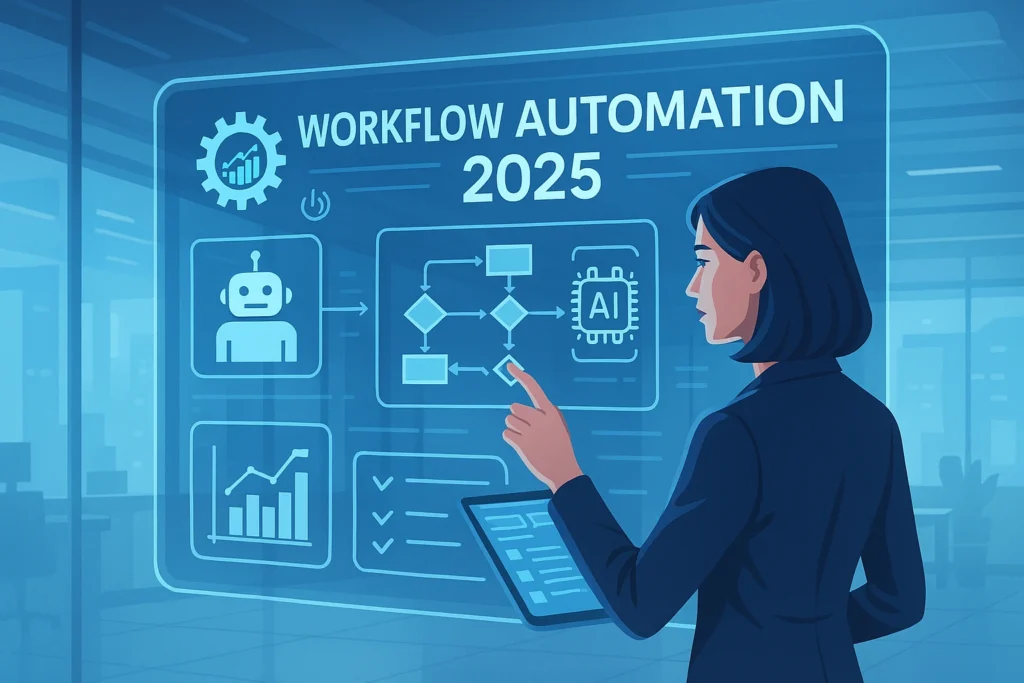In the rapidly evolving business landscape, staying competitive means embracing innovation, and nothing embodies this more than Workflow Automation. As we look towards Workflow Automation 2025, it’s clear that the future of work will be defined by intelligent systems, hyper-efficiency, and a profound shift in how tasks are managed and executed. This article explores the transformative trends, technologies, and strategies that will shape workflow automation in the years to come, providing a roadmap for businesses poised to thrive.
Table of Contents
- Introduction to Workflow Automation in 2025
- Key Trends Driving Workflow Automation in 2025
- The Role of AI and Machine Learning
- Hyperautomation: Beyond Basic Automation
- Anticipated Benefits of Advanced Workflow Automation
- Navigating Implementation Challenges
- The Future Outlook
Introduction to Workflow Automation in 2025
The concept of workflow automation isn’t new, but its scope and sophistication are accelerating at an unprecedented rate. By Workflow Automation 2025, we anticipate a pervasive integration of automated processes across nearly every industry, moving beyond simple task automation to intelligent, adaptive systems capable of complex decision-making. This shift is powered by advancements in artificial intelligence, machine learning, and cloud computing, making automation more accessible and powerful than ever before.
Key Trends Driving Workflow Automation in 2025
Several significant trends are converging to reshape workflow automation:
1. AI-Powered Decision Making
AI will move beyond predictive analytics to prescriptive actions, automating decisions within workflows. This means systems will not only identify bottlenecks but also automatically reallocate resources or adjust priorities.
2. Low-Code/No-Code Platforms
The democratization of automation will continue, with low-code/no-code platforms enabling business users, not just IT, to design and deploy complex workflows. This significantly accelerates adoption and innovation.
3. Integration of RPA and AI
Robotic Process Automation (RPA) will become smarter by integrating deeply with AI capabilities, leading to Intelligent Process Automation (IPA). This allows bots to handle unstructured data, understand natural language, and learn from experience.
For more insights on the history and evolution of business process management, you can refer to Wikipedia’s article on Business Process Automation.
The Role of AI and Machine Learning
Artificial Intelligence and Machine Learning are no longer just buzzwords; they are the engines driving the next generation of workflow automation. ML algorithms will continuously optimize workflows by learning from past performance, identifying patterns, and predicting future outcomes. This adaptive intelligence ensures that automated processes are not static but evolve with business needs and external factors.
Hyperautomation: Beyond Basic Automation
Gartner defines hyperautomation as a business-driven, disciplined approach that organizations use to rapidly identify, vet, and automate as many business and IT processes as possible. By 2025, hyperautomation will encompass a blend of technologies including RPA, AI, ML, Business Process Management (BPM), and Integration Platform as a Service (iPaaS). This comprehensive strategy aims for end-to-end automation, eliminating silos and creating a seamlessly integrated operational ecosystem. Businesses leveraging hyperautomation will gain significant competitive advantages.
Consider the transformative impact on customer service workflows, where AI-powered chatbots can resolve complex queries, or in financial operations, where invoice processing becomes fully automated from receipt to reconciliation. This level of automation frees human employees to focus on strategic initiatives and creative problem-solving, such measuring the effectiveness of RPA implementation best practices.
Anticipated Benefits of Advanced Workflow Automation
The widespread adoption of advanced workflow automation is expected to yield substantial benefits across various organizational functions. Here’s a quick overview:
| Benefit Category | Description | Example Area |
|---|---|---|
| Increased Efficiency | Faster execution of tasks, reduced manual effort. | Onboarding new employees, invoice processing. |
| Cost Reduction | Lower operational costs due to optimized resource use. | Reduced need for manual data entry staff. |
| Improved Accuracy | Minimization of human error in repetitive tasks. | Data validation, compliance checks. |
| Enhanced Compliance | Automated adherence to regulatory requirements. | Audit trails, policy enforcement. |
| Better Employee Experience | Employees focus on high-value, engaging work. | Elimination of tedious administrative tasks. |
| Scalability | Ability to scale operations up or down rapidly. | Handling seasonal peaks in customer inquiries. |
Navigating Implementation Challenges
While the benefits are clear, implementing advanced workflow automation in 2025 won’t be without its hurdles. Key challenges include data integration complexities, ensuring data security and privacy, managing organizational change, and upskilling the workforce. A phased approach, strong leadership buy-in, and investment in employee training will be crucial for successful adoption.
The Future Outlook
As we advance towards 2025, workflow automation will no longer be a luxury but a necessity for businesses striving for agility, efficiency, and innovation. The fusion of AI, ML, and hyperautomation will create a more intelligent and responsive operational backbone, fundamentally transforming how work gets done. Organizations that proactively embrace these changes will be best positioned to lead their industries into a new era of productivity and growth.


